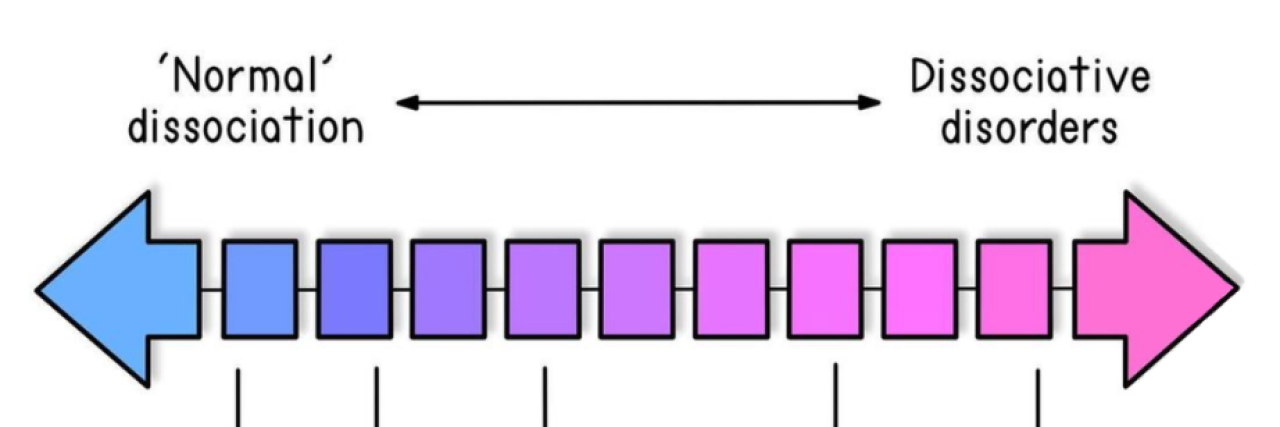I was diagnosed with dissociative identity disorder (DID) in 2013. I felt alone, scared and confused. The trauma therapy I have received has helped me learn about the spectrum of dissociation, where I was on the spectrum, and build coping strategies for living well with my dissociative disorder. Inspired by the infographic on Instagram by @what.is.mental.illness, we are exploring the spectrum of dissociation. As the artist illustrates, dissociation occurs on a spectrum ranging from “normal” everyday dissociation to dissociative disorders, such as dissociative identity disorder.
View this post on Instagram
The Spectrum of Dissociation
At the base level, dissociation is being disconnected from the here and now. This is an experience everyone has at some point in their lives. Examples include moments of daydreaming during class, getting lost in a really good book or movie, or “losing touch” with an awareness of one’s immediate surroundings like being in a crowded grocery store or while in Ikea.
Dissociative moments have also been described as an experience of disconnecting from one’s current environment to assist with calming or focusing, as part of a ritual related to one’s religion or culture, or as a side effect of substance use, a side effect to taking or ceasing a medication, or a symptom of a mental health issue.
After these everyday moments of dissociation is the experience of dissociation connected to post-traumatic stress disorder (PTSD), trauma, and dissociative disorders. Previous experience of trauma, including ongoing traumatic events over a length of time, has been associated with the development of dissociative disorders and is connected to dissociation as a coping skill that is effective in navigating the traumatic experiences as well as the after-impact.
Dissociative disorders often affect a person’s memory (i.e., memory loss, amnesia), identity (i.e., integration/disintegration connected to parts of one’s self), emotion, perception, behavior and sense of self in different ways and to different degrees ranging from minimal impact to significant impact. When dissociation is severe to where it is affecting one or more aspects of a person’s everyday life, a dissociative disorder may be considered and diagnosed by a mental health professional.
When it comes to dissociative disorders, there are three main types of dissociative disorders including dissociative amnesia, depersonalization/derealization disorder and dissociative identity disorder.
Dissociative amnesia occurs when a person loses the ability to recall information about oneself — not normal forgetting — following a traumatic or stressful event in their life. The types of dissociative amnesia include:
- Localized: This is the most common type where a person is unable to remember an event or a period of time such as an evening or day.
- Selective: This occurs when a person is not able to remember certain parts of an event or events during a specific period of time.
- Generalized: This type is rare and involves a person completely losing their identity and the history of their life.
Depersonalization and derealization disorder involves the significant ongoing or recurring experience of:
1. Experiences of unreality or being detached from one’s mind, self or body (i.e., depersonalization).
2. Experiences of unreality or being detached from one’s environment or other surroundings makings things and people in the world around them not feel real (i.e., derealization).
3. Both.
Dissociative identity disorder (previously known as multiple personality disorder) is associated with significant ongoing trauma occurring during childhood. Symptoms include the existence of two or more distinct identities accompanied by changes in one’s behavior, memory and thinking; the presence of memory gaps related to everyday events, personal information, and/or one’s trauma; and one is experiencing severe distress or problems in different areas of their life due to these symptoms.
Tips for Coping With Dissociation
- Seek support from a mental health professional.
- Use of grounding and visualization techniques. These techniques help bring us back to the present moment when experiences flashbacks, unwanted memories and negative or challenging emotions come up.
- Keeping a journal can help you understand, express and remember different parts of your day and experiences.
- Take time to care of yourself.
- Engage in self-care and stress-management practices.
- Talk to other people with similar experiences through peer or professional-led support groups, online forums, workshops and psychoeducation offerings.
- Use practical strategies. Examples of these include the use of notes, reminders, calendars, alarms, watches, maps, and preprogrammed numbers in your phone for help if needed.
- Navigating encounters of stigma. There are a lot of misconceptions and stereotypes about dissociation and dissociative disorders. Know and uphold your boundaries. Sharing educational materials about dissociation, using your voice and sharing your story, engaging in self-advocacy practices and seeking support from people who understand can all be helpful in breaking down stigma.
Image via what.is.mental.illness on Instagram

